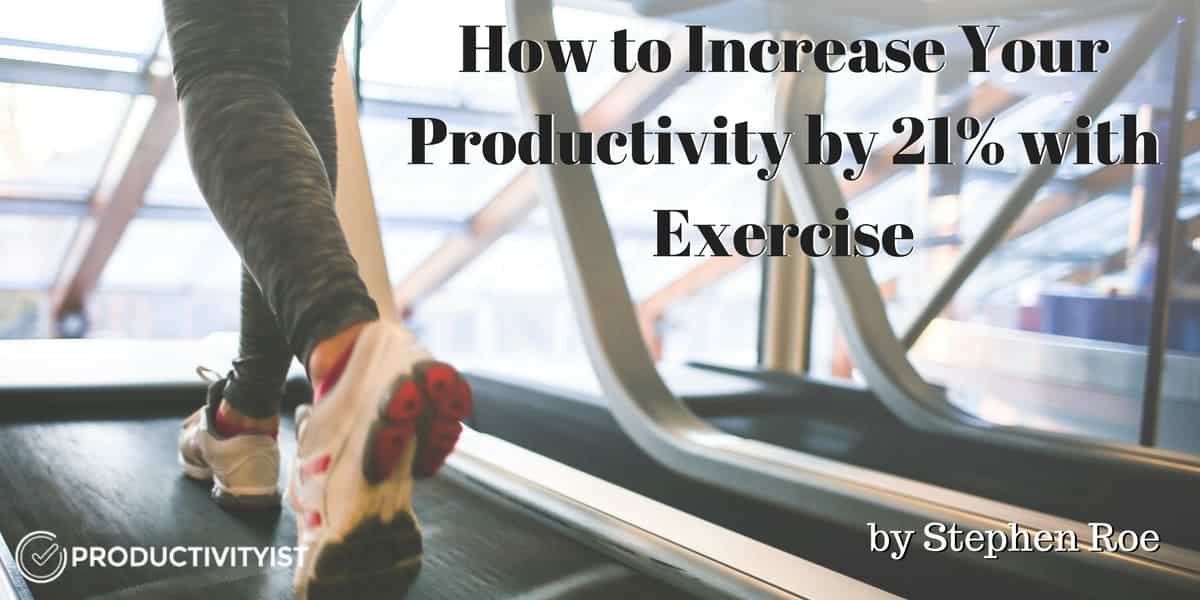
Today’s guest post is by Stephen Roe. Stephen writes at Thoughtful Growth, where he applies the scientific method to personal development. Want a six-step method guaranteed to make exercise a habit? Get Stephen’s free guide Habit-Forming Morning Routines.
You’ve tried all the apps. You’ve adjusted your workflow. You’ve tweaked your schedule. You’ve worked hard to be more productive, but you’re still not where you want to be.
What if I told you that research has proven there’s another strategy that will increase your productivity by 21%?
Would you try it?
Of course you would. And that strategy is exercise.
Does exercise have a direct impact on productivity?
We all know that a healthy lifestyle will help you in the long-term. But can exercise boost your productivity today?
Briston University conducted a study on 200 employees at three organizations. The employees evaluated themselves on a day with exercise and a day without.
The results were incredible. On workout days, participants’ scores were 21% higher for concentration on work, 22% higher for finishing their work on time, 25% higher for working without unscheduled breaks, and an incredible 41% for feeling motivated to work.
Another survey of 683 workers found that fitness “significantly impact[s] employee work performance.” A study of six dental offices showed that 30 minutes of exercise increased self-rated productivity.
It’s clear that exercise has immediate benefits. But what types of exercise are best?
The best type of exercise for productivity
We usually believe a vigorous workout will help motivate us, but research shows the opposite.
In reality, less active exercise provides the greatest productivity benefits. Research on fatigue shows that low-intensity exercise reduced symptoms of fatigue better than a high-intensity workout.
Another study showed attention, memory, and problem-solving plummeted after vigorous cycling. Those effects continued for 20 minutes, at which point the researchers stopped tracking. The group that cycling at a slower pace was unaffected. Low to moderate exertion seems to provide the most benefit to productivity.
If you love yoga, golf or dancing, start there. If you’re not sure which form of exercise to begin, try walking. Science shows walking provides many health benefits, you don’t need special equipment, and walking will fit into any spare block of time.
Speaking of which, when is the best time to exercise?
When to exercise for maximum productivity
Research on cycling and swimming has proven that your strength peaks in the evening. But mood and energy are what increases your productivity, not strength. The University of Glasgow has shown that exercise boosts these two areas at all times of the day.
Based on the information available, you’ll be most productive with a longer workout in the morning and brief exercise during the day to lift your mood.
But working out twice a day seems excessive, right?
The good news is that there is no need for grueling hours of physical training.
The length of your workout: less is more
You already know the answer: you should exercise 30 minutes each day. Scientific studies and the U.S. Government support that number.
The problem is that many people give up if they can’t meet that goal.
So how little can you exercise in one session? The American College of Sports Medicine recommends exercise in increments of no less than 10 minutes at a time. So based on the research, one weekly 10-minute workout is better than nothing.
The foolproof method to fit exercise into your busy schedule
Habits can be tricky. But here’s the thing: it’s better to have a consistent 10-minute workout than a 60-minute routine you never do. The less time commitment, the more likely you will be to build a habit.
If any exercise seems impossible, the following strategies will help turn it into a routine that works.
1. Start small
It’s a great idea to rank the likelihood of completing your plan. Be completely honest with yourself. If it isn’t a 9 or a 10 of a possible 10, reduce the effort. It’s better to walk 30 seconds and have a habit you can increase a month later than to set a goal of 30 minutes and never reach it.
2. Have fun
Choose an exercise you like. If you dislike them all, create an incentive. Find an app that makes it a game, or reward yourself. Working out with a friend is also a fun way to stay healthy.
3. Overcome barriers
Don’t worry about equipment, nutrition, or tracking data. Each of those steps is fine, but extra work kills new habits fast. The fewer barriers standing in the way, the more progress you’ll make.
4. Schedule it
Mark exercise on your calendar, or build it into another habit. If you follow the same routine each morning (and you should), you can exercise every day as part of your routine.
Exercise your way to better productivity
Exercise has a clear impact on your productivity. If you’re serious about finding the extra edge and accomplishing more, it’s time to stop pretending exercise is just for Olympic athletes.
Ten minutes today will improve your mood, increase your energy, and help you do more.
Why wait?

